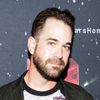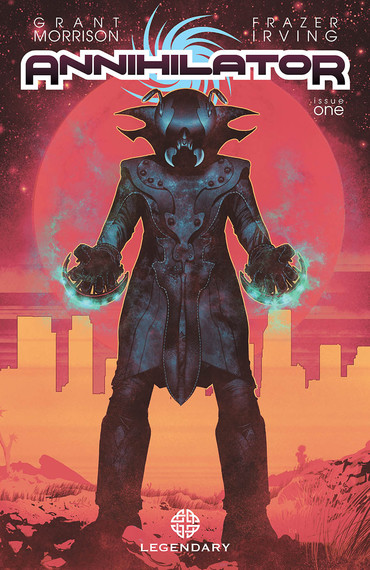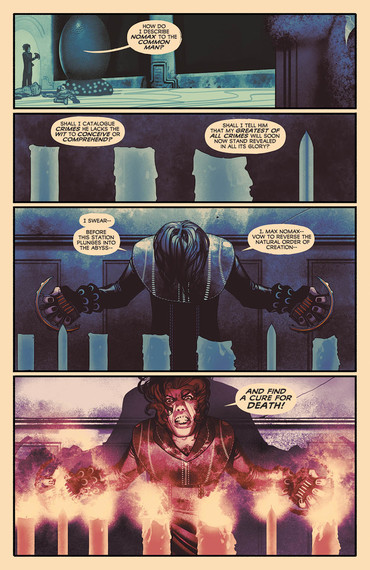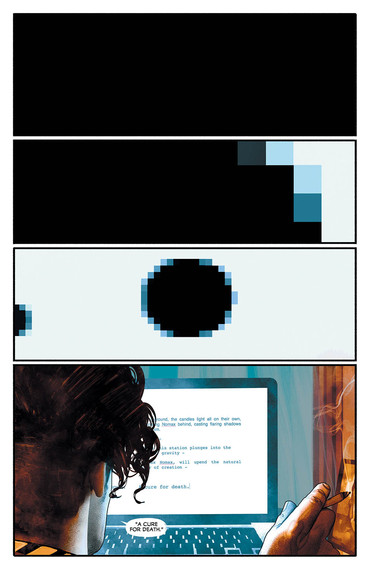Grant Morrison deals with big concepts and bigger ideas. And in the world of comic books, the Scottish writer who has taken on the X-Men, Batman, Superman and more is known for telling mindblowing tales. But a Morrison story makes readers think as well as make them scratch their heads. He doesn't just spin a yarn, he spins a weird, massive ball of twine that requires you to concentrate in order to entangle.
Such is the case with Annihilator, Morrison's six-part series from Legendary Comics, which debuted Wednesday, Sept. 10. To describe it is to underserve what Morrison and artist Frazer Irving are crafting, but Annihilator is a haunted house-in-space sci-fi/horror story. Yet that is also the guise for a Faustian tale set in modern-day Los Angeles.
The plot revolves around Hollywood screenwriter Ray Spass (pronounced Space) who is overdue for a hit. But the antihero of Spass' new script, Max Nomax, turns out to be quit real. As Spass writes about his "cursed and haunted mausoleum in orbit around the galaxy's blackest black star," he is also facing a black hole in his brain - a tumor that is numbering his days.
Much like his current DC Comics book Multiversity, there is a lot of bleeding between realities between the pages. But within Annihilator, there is also a creeping sense of dread and a nihilistic philosophy permeating the characters. This is a surreal horror trip with a Beverly Hills zip code.
In the interview that follows, Morrison and Irving peel back the layers to share just a little of what's behind Annihilator.
Los Angeles, where the comic is set, can be so bright and sun-drenched, yet have incredibly creepy things crawling in its shadows. Why is that, and how much of that reputation is due to the Hollywood machine?
Grant Morrison: Hollywood, to me, is at the beating heart of the whole American enterprise. I've always felt that The Wizard of Oz was so resonant because it simply and effectively mythologizes America's relationship with the rest of the world.
America -- as the rest of us see it, onscreen -- is the giant head of the Great and Terrible Oz, the fearsome mask of light, an illusory, fictional territory with its frontier, pioneer spirits and its brave soldiers, astronauts, gangsters and superheroes. It's pure propaganda for a worldview so seductive most of us swallowed it wholesale and embraced a singular vision of a hands-on hips, chest and jaw out-thrust, America that was -- to the best of my knowledge -- often very much at odds with actual reality of life in the United States. Behind the mask and the booming voice we find the little men who pull the levers, and balance the books and hire the glamorous actors to create a dream vision of America at its best and most exciting. Futuristic, self-confident, creative, and strong. That idea of that mask, the handsome, commanding face which dazzles the rubes and distracts from the wires and pulleys and dry ice machines seems emblematic of America and the Hollywood machine, so it's at the heart of Annihilator. The hypnotic glitter around the disillusioning truth in the middle - that's our subject in this book.
How did Grant pitch this to you, Frazer? As a haunted house story or sci-fi story?
Frazer Irving: The haunted house bit was one of the easiest parts to pitch because we were shouting in a loud restaurant. He couldn't really use much word trickery to entice me so he used kind of one note pitches. But the haunted house thing, I thought, well a house haunted, I can work with that. He didn't go into that much detail about the science fiction or the philosophy behind it. But I took that as a given. I knew if it was a haunted house in space, it's going to be sci-fi stuff I can invent. And I knew Grant would bring the weirdness with him. I pretty much took this on face. That's the way I like to work in this business. I don't want to gnaw over a pitch too much; it's what you do with it that counts.
Which do you think has the more potential to be scary, science fiction or "traditional" horror? Why? Which genre do you think Annihilator fits more within?
Morrison: Max Nomax asks this very question in Annihilator #3. I usually start with the idea of tackling a genre and trying to find a twist. Annihilator started out with the idea of doing a real life take on Hollywood crosscut with a Tom Cruise type sci-fi story. In the end, I think it's wound up as a sort of Space Gothic!
Otherwise, I think anything can be scary. Everything can be scary; cereal packets, the beaks of parrots, tomorrow, cancer or bloody hammers. Obviously the horror genre goes out of its way to concentrate on hypnotically invoking a fear response but real life provides its own fair share of serious shocks. Annihilator is a hollow laugh in the face of the abyss, I think, but there are certainly some unsettling moments. My next new project Nameless is more of an out-and-out horror story but it too has science fiction elements, so maybe I just like that intersection of genres. I'd say Doctor Who at its best could be described as sci-fi horror and Event Horizon, which I love, owns that genre.
The artwork of Annihilator is stunning in print but is geared toward digital reading. How is that a benefit to a horror book like this?
Irving: There's a cut-off point with print where if you've got detail on lines or a certain thickness the printers wouldn't pick it up. With Annihilator, I've got certain details I never would have drawn because the print would have lost them. Like the detail of somebody's eye. It's a lot crisper than my previous work. I found I actually enjoy putting background details in. Whereas before I saw it as a chore, now that I know it can be seen, I'm seeing the opportunities for enhanced storytelling within the comic book page -- by having background actors or shadows or little details on TV screens. In that respect, I'm having to learn whole new tricks to convey the horror aspect. Before I'd use shadows, now I can have little faces reflecting off windows in the background and put details in in very sneaky ways.
Can you discuss the elements of Annihilator that are almost autobiographical and reflect your own experiences in Hollywood?
Morrison: I'm not much like Ray Spass at all, other than being familiar with deadline pressures and knowing a bit about the particular problems of trying to work on a screenplay for a big studio picture.
Otherwise, I don't smoke, I've never hired a hooker, taken part in an orgy or used amphetamines of any kind so Ray's got me hammered on the hedonism front! I've also managed to live this long without being diagnosed with an inoperable brain tumor, thank God.
Unlike Ray, I don't rely on Hollywood to pay my wages and to be honest, I'd much rather be a successful comic book writer doing exactly what I want with collaborators I can trust and rely on, than a screenwriter hustling for gigs or suffering the endless deconstruction and reconstruction of studio notes and attendant humiliation at the hands of studio executives.
My own experience of Hollywood is more positive. Kristan [Morrison's partner] and I bought an apartment just off the Strip and we spend four months of the year there, absorbing life-giving Vitamin D and soaking up inspiration. The arts scene is electric and lively in Los Angeles. Most of my friends are musicians, with a smattering of artists, writers, directors and photographers. I tend not to hang out with actors so perhaps I'm missing something quite essential about the character of the town but I find it very energizing and inspirational. Back home in Scotland where I spend most of the year living and working in the country, there's nothing to do but watch weather patterns and wild animals. I rely on Los Angeles for input.
Who is Ray based on, then?
Morrison: I based Ray Spass on characteristics of several real people I've met in in Los Angeles. Other autobiographical elements are a little grimmer; my mother died last year after losing her short term memory to dementia. The sense of her powerful personality spiralling around the hole which eventually consumed her gave Annihilator some of its Saturnian heavy gravity. The book allowed me to work out a lot of my feelings about mortality and futility in what I hope is a fairly amusing and exciting way.
Frazer, this book seems like a showcase project for you both as creators. Why is that?
Irving: I would say it's because it's the first time we've been left to do our thing. It is the closest thing to doing creator owned. In that respect, we don't have to play with anyone else's toys. It isn't necessarily a showcase; that sounds more like a cynical marketing ploy on our part where we're trying to display our wares to get another job. This isn't that; this is a representation of the best we can do at this point in our careers. This is a monstrosity we're both very proud of. I think it will be used as my yardstick for everything from this point onwards. For me this is important because I think I just want to show off and I haven't had a chance to show off before.
Is Nomax something of a fallen angel character? If so, and he is your version of Milton's Satan, what are the literary origins of Spass?
Morrison: Not so much "something of a fallen angel character," he is the Fallen Angel -- the original source for all our stories of rebel angels and dissident anti-heroes.
Spass is more of a Faust character for me. Hollywood is the capital city of devil deals - a big part of Annihilator is about the outcome of making a deal with the devil. If it's anything, it's a modern Faust tale.
There is an orgy scene in issue one, and the bodies on display are diverse instead of following the same types comic readers have seen so often. What was your reasoning behind that choice?
Irving: Obviously I've always tried to represent what I see outside my window in my work, but it has had to be more of a conscious decision more recently. There is that instinct for an artist to draw what is easy, so end up drawing the same nose or same kind of ear. I've started thinking every single character has to have a personality. When I was drawing that scene, I was thinking, 'What would these people be doing?' How long would they be doing it, what is their motivation? That gives me the look, how they stand, how they dress themselves. It is almost the method acting of comics. I have to get in the heads of these people to make them credible or plausible. It is an issue of every comic artist right now. It is our social responsibility in how we draw how to reinforce or deal with visual stereotypes. I have no problems drawing sexually objectified human beings as long as that objectification has a reason and it isn't a one-note. It isn't a dialtone, it is a symphony.
Grant, that orgy scene is also a Halloween Black Mass. Will you reveal the craziest Halloween you've had?
Morrison: I wish I had something to reveal! I think I've only been to three Hallowe'en parties in my life since I was a teenager. One I went as Dracula, another as Lord Byron. In both cases, being a bit of a poser, I didn't have to change my day clothes. The aftermath of the Byron party was quite super-heated but that's nobody's business. We've had a few good house parties but we tend to ignore Halloween.



